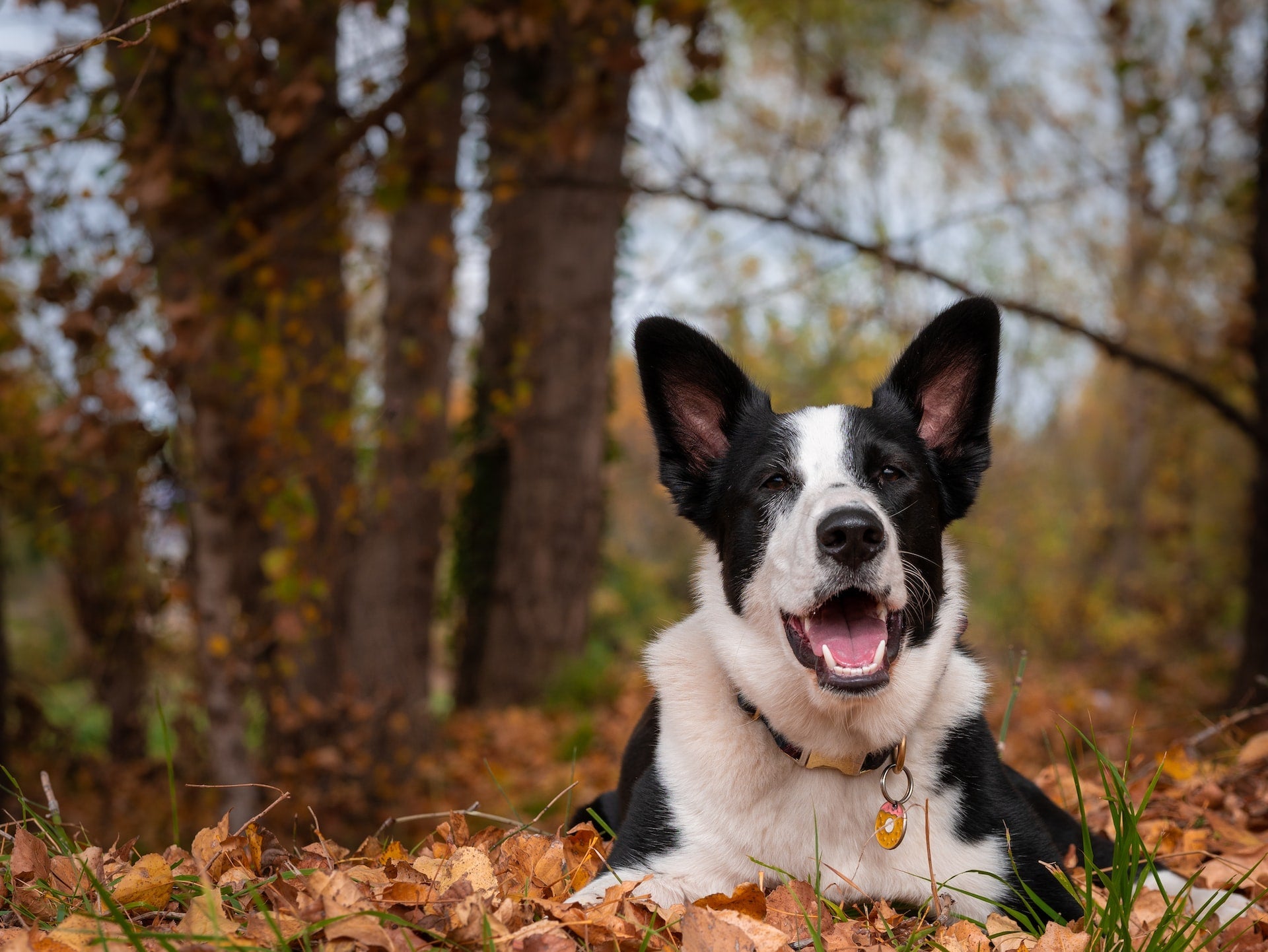Canine Cognitive Dysfunction Syndrome (CCD or CDS) is a condition that can develop as your dog's brain ages – similar to dementia in humans. The syndrome leads to behavioral changes, decreased responsiveness, and difficulties with learning and memory.

Cognitive decline starts with mild symptoms and progresses over time, but that doesn't mean your old dog can't still enjoy life. Here are five ways to mentally stimulate an aging canine's mind and keep their mental faculties sharp:
1) Take More Frequent, Shorter Walks
Walking is great for older dogs as it provides both physical and mental exercise. Keeping your dog moving as they age is great for other aspects of their health. But the sights, smells, and sounds your dog experiences on a walk help to stimulate their brain.
Take your dog on sniff walks, sometimes called a "sniffari", to give them a chance to explore at their own pace. Don't rush your dog forward on your usual route. Instead, give them time to sniff to their heart's content.
These types of walks will be shorter, distance-wise, but they will be much more fulfilling for your dog's brain. For that reason, you'll want to take these shorter walks more frequently if you can.
2) Provide Age-Appropriate or Therapeutic Activities
As your dog ages, it can be more difficult to find an appropriate exercise that can keep them active without causing discomfort. Exercise is important for your dog's brain health, but you also need to consider other aspects of their health.
Consider age-appropriate or therapeutic activities that still allow your dog to exercise yet are easy on their joints.
Underwater treadmills and wading pools are both great therapeutic options. The treadmill allows your dog to exercise their muscles, while the added water takes the pressure and stress off their joints. Similarly, swimming in a wading pool helps your dog to not only exercise but also relax. Be sure to observe your dog closely while performing any of these activities and look for any signs of fatigue.
3) Teach New Tricks
While trick training may seem like an activity that only champion show dogs participate in, learning new tricks is something every dog can benefit from.
Learning a new trick takes mental focus and it challenges your dog's brain. One 15-minute training session can leave your dog feeling more tired than a 30-minute walk because mental stimulation requires a lot of concentration from your dog.
Trick training is also fun for both you and your four-legged friend. It provides more opportunities for you to bond and strengthen your communication skills. Plus, the emotional connection is also great for your dog's brain.
There are a variety of tricks that you can teach your dog, and you don't have to stick to well-known favorites like "shake" or "roll over." Get creative and look for opportunities in your dog's everyday life to teach them something new.
4) Provide Puzzle Toys
Puzzle toys provide fantastic mental stimulation for your dog because they challenge them to solve a problem. In order to be rewarded, your dog has to think through their actions and find the solution to the puzzle.
There are many types of puzzle toys available, so you can try a variety to find which ones your dog likes the best. Many puzzle toys feature compartments you can put treats into, so your dog has to figure out how to get to their prize.
Snuffle mats are also a popular option. They're made up of different fabric pieces that form a complex maze of nooks and crannies. Simply sprinkle treats over the mat or hide them underneath the strips of fabric, and let your dog use their nose to find the yummy snacks.
5) Create Enriching, Stimulating Environments
Sometimes exploration is the best mental stimulation for your dog, especially when it involves all their senses.
If your dog is used to the same walking routine, try switching up their usual route to explore a new trail or walk in a new neighborhood. Take your time on these walks, and let your dog sniff every new smell they can find.
If your dog gets distracted by a new sound or they're interested in something they haven't seen, give them the opportunity to observe it before moving on. The more new information their brain takes in, the more stimulated it becomes.
Taking your dog to a local pet-friendly store is another great option for new sights and smells. Pet stores are typically dog friendly, and there are a variety of local hardware stores, coffee shops, and other spots that love dogs.
If your local neighborhood isn't enticing to your dog at the moment, consider signing up for a scent work class. These classes not only teach your dog a new skill (which is great mental stimulation), but the skill relies on your dog's ability to smell in a new environment.
Other Great Ways to Support Your Dog's Brain Health
Mental stimulation isn't the only way to help support your dog's brain health. Try one of these tips as well.
Don't Over-Exert Your Dog
It’s important to remember that mental stimulation can be exhausting for dogs, even more than physical exercise. While you want to keep up with a regular routine of mental stimulation, you never want to over-exert your dog.
Pay attention to your dog's behavior and body language. If they ever seem overly tired or frustrated, it's time to end the activity for the day.
Don't Change Your Routine Too Often
Dogs are creatures of habit, and having a consistent routine can reduce stress and build their confidence at any age. However, as your dog ages, they can become confused even in familiar places. That's why it's important not to change your routine too often.
If you do need to make a change, such as moving to a new house, take the time to slowly ease your dog into their new surroundings. Let them explore one room at a time until they're comfortable with the whole space.
Feed the Brain
The medium-chain triglycerides (MCTs) in virgin coconut oil and MCT oil are highly beneficial for brain health. In fact, studies have shown that dogs that take MCT supplements show significantly better brain performance, especially when trying to perform a difficult task.
For best results, experts suggest using a therapeutic virgin coconut oil that's 100% certified organic, non-GMO, raw (true cold-pressed), and non-hydrogenated. Therapeutic-grade oil such as CocoTherapy Organic Virgin Coconut Oil contains high levels of MCTs that are proven to support brain health. CocoTherapy TriPlex MCT-3 Oil is rich in Caprylic and Capric acids, which are rapidly broken down and used as instant energy. This means it’s highly beneficial for senior dogs that need an immediate energy boost.
Keep Your Senior Dog Healthy with Mental Stimulation
As your dog ages, it's natural for them to slow down and for their needs to evolve. While a certain level of cognitive decline is expected, you can still help keep your dog's brain healthy and sharp with regular mental stimulation and smart lifestyle choices.
By providing your dog with opportunities to explore their environment, try new things, and engage their senses, you can help support their brain health at any age.
Check out our previous blog post, Is Your Senior Dog Showing Signs of Cognitive Decline? for more information about this important topic.



